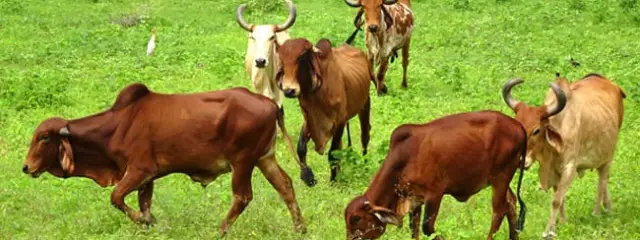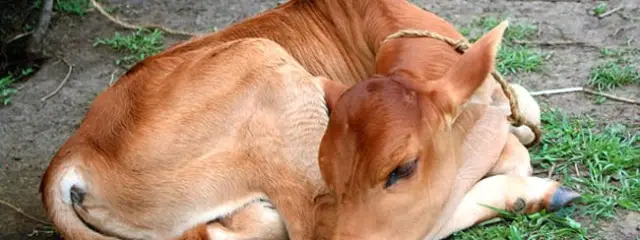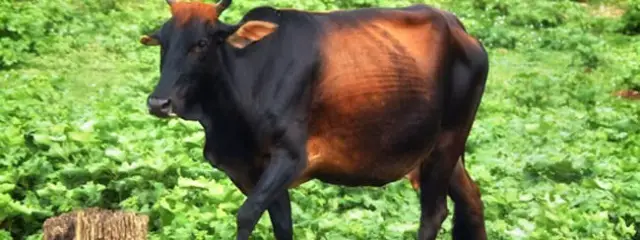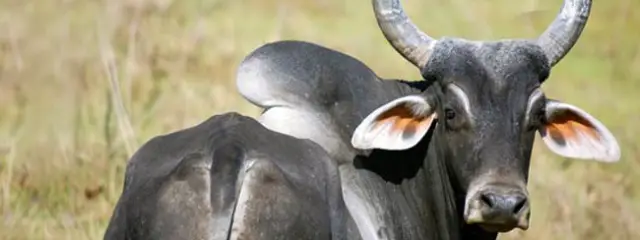The Zebu is a breed of domestic cow from Asia, which has been domesticated since 3,000 B.C. Today, there are about 75 breeds, evenly divided between those living in Asia and those living in Africa.
Zebu are used as draft animals, and are farmed as both dairy and beef cattle. This breed is actually a subspecies of the domestic cow, and its scientific name is Bos taurus indicus. Read on to learn about the Zebu.
Description of the Zebu
It is easy to recognize because it has a large hump on its shoulders, and a long flap of skin, known as a “dewlap,” on its chest. Many Zebu also have floppy, droopy ears. The Zebu is one of the smallest breeds of cow in the world. They are usually gray or red in color, have horns, and loose skin.
At their largest, Zebu cattle stand up to 3.5 ft. tall at the shoulder, and weigh up to 600 lbs. or more. The similar Brahman cow originated from these cattle. As a comparison, Brahman cattle reach weights of 2,000 lbs. or more!
Interesting Facts About the Zebu
Zebu have been domesticated to be productive in hot, humid environments. Because of this selection by breeding, they are smaller than other domestic cattle, have a lower metabolic rate, and have more efficient sweat glands. Learn more about what makes Zebu cattle unique below.
- Origin – Humans bred this unique cow in southern Asia. Their small stature makes it easier to move through dense jungles in that region. They are also much more adapted to hot and humid temperatures.
- Perks Against Pests – Their humid, jungle upbringing also featured another interesting challenge… parasites. Parasites and diseases thrive in humid and warm environments, so Zebu cattle are particularly resistant to parasites and other illnesses that different cattle breeds are not resistant to.
- Zebu Cattle Today – Because they are so resistant to high temperatures and other unfavorable conditions, these cattle live in many different areas today. People keep this breed in the United States, Brazil, India, Africa, and in southern Asia.
- Milk Production – Zebu cows produce one-half gallon (2 liters) of milk per day, whereas European high-performance breeds have a peak production of about 21 gallons (80 liters) per day.
- Sacred Animal – In India, Zebus are sacred, and are used only as draft animals, and for producing milk.
- As an Icon – Zebus are featured on the official stamp of Madagascar.
Habitat of the Zebu
This breed is much more adapted to harsh conditions than some other cattle breeds. Though they are not tolerant of cold regions, they are troopers when it comes to serious heat and humidity.
Their habitats are primarily tropical forests, jungles, wetlands, and swamps. They also live in open grasslands, meadows, and plains. While there are some feral populations, most of these cattle live under human care on farms and pastures.
Distribution of the Zebu
Zebus originate in southern Asia, and humans transported them to Africa, India, and the Middle East shortly after. Nowadays, this breed is also popular in South America and the United States. There are thought to be 270 million Zebu in India, 155 million in Brazil, and 2 million in the U.S.
Overall, these cows do not have a “wild” distribution, and humans control their populations and movements. People usually keep this breed in hot, tropical regions.
Diet of the Zebu
Like all cattle, Zebus are herbivores. They are grazers rather than browsers, which means that they feed on grasses rather than browsing for leaves and shrubs.
Also, like other cattle and members of the Bovidae family, they are ruminants. Ruminants have multi-chambered stomachs, and regurgitate their food to chew it again. After grazing, the Zebu picks a quiet spot to lie in the shade and chew its cud.
Zebu and Human Interaction
Humans and Zebus interact all the time, because humans have domesticated these cattle. They are raised primarily for beef and milk, even though their meat is not considered very tasty.
Their dung is often used for fuel or fertilizer, and they are also used as draught animals, pulling carts, plows, and other farm equipment. They are also used for leather, and their horns and bones are often used to make jewelry, ornaments, and cutlery.
In some countries, such as Madagascar, Zebus are a sacrificial animal and they are killed and eaten at occasions such as marriages, funerals and New Year’s Eve.
Domestication
Humans control every aspect of this animal’s life in some way, since their domestication in about 3,000 B.C. There are some small feral herds, but the vast majority of these animals live in human care.
Humans choose which ones to breed, where they live, and what they eat. Some humans use them as food, for their milk, or to help them plow their fields for agriculture. This breed is also popular for its size as a “miniature” cow.
Does the Zebu Make a Good Pet
Unless you own a farm, a Zebu would not make a good pet for you. Even if you do own a farm, it is important to understand everything that goes into their care before choosing any type of pet. Even though they are miniature cattle, an adult bull can weigh up to 600 lbs. and is more than capable of injuring you.
Zebu Care
Like all cattle, Zebus are social and must live in groups. Their enclosures should be secure, and provide them with plenty of space. They need lots of grass to eat, and supplemental hay when the grass does not provide enough nutrition for them.
Like any animal, they need veterinary care, and this is quite costly. Not all veterinarians work with livestock, and it can cost a lot of money to have a vet come out to your farm to examine your animals.
Behavior of the Zebu
Like other cattle, Zebu are a prey animal and much of their behavior is adapted to this niche. For example, their eyes are on the sides of the heads, giving them vision of 330 degrees.
The amount of time spent grazing depends on environmental factors, but is usually 8 – 9 hours per day. Zebu show typical social behaviors of domesticated animals, such as group cohesion, dominance, and leadership. Knowledge of these behaviors is very useful when handling the animals.
Even though they are small, this cow behaves much like any other breed. They are diurnal, and most active during the day. Most of their time is spent grazing for food, or resting and chewing their food for a second time.
They live in herds, and have a social structure amongst themselves. Herds contain one male and many females, all of which have their own spot in the pecking order.
Reproduction of the Zebu
Zebu become sexually mature at approximately 44 months of age. A single male breeds with multiple females, and does not participate in the care of the calves. The female is pregnant for about 285 days, but this varies depending on her age and health. If the calf is a male, the pregnancy (gestation period) is often shorter than for a female calf.
Most Zebus give birth to a single calf, though twins are also common. The calves nurse from their mother for about six months. Once they are a year old, most calves are fully independent.













![Red Angus Closeup of a beautiful Red Angus cowPhoto by: U.S. Department of Agriculture [pubic domain]https://creativecommons.org/licenses/by/2.0/](https://animals.net/wp-content/uploads/2020/03/Red-Angus-4-238x178.jpg)












![Red Angus Closeup of a beautiful Red Angus cowPhoto by: U.S. Department of Agriculture [pubic domain]https://creativecommons.org/licenses/by/2.0/](https://animals.net/wp-content/uploads/2020/03/Red-Angus-4-100x75.jpg)

